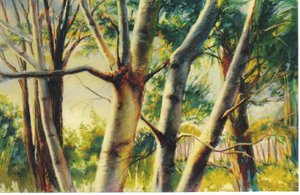How do you get in the zone as an artist?
Go on an adventure.
You are free to make choices and free to change your mind.
How do you get in the zone as an artist?
Go on an adventure.
Can you imagine the adventure of a drop of rainwater must have? From the heavens to the ocean and whatever is in between. It drops, lands on a leaf, following millions of other raindrops and becomes a powerful force of nature. The wind, hot or cold, make it a drop of water or a snowflake. But my story is just a small part of the journey of one rain drop.
I was in Brown County Indiana State Park, sketching and photographing the forests and streams, searching for those perfect compositions that inspire great works of art. I saw hills - mountains - cliffs, made of limestone, and creeks that all had a history with the rainwater that carved its way throughout the hills down to the streams. I could feel the wind, the sun, and the cool mountain air. This is what I want to see in the paintings.
I did a detailed pencil sketch, hunting for a composition. I followed that with a broad value sketch using vine charcoal and searching for direction. The land pitched and moved in so many different directions with cracks in between the layers of limestone. There were abundant trees growing tall like telephone poles and a stream trickling down from the secret places in the hills to a lake.
I chose to use this study for a demonstration at a gallery solo exhibition. For the demonstration I used pastels. In broad strokes I started laying in the cool colors with shades of blues for the sky and greys for the trees. Then I began laying large warm browns and ochre for the leaves on the ground. The hills were alive with rust colored leaves flying to and fro in the winds.
As the water in the stream came forward, the colors got stronger and the details in the rock seemed necessary. I started softening the edges in the distance and sharpening the edges in the foreground. Then I applied layer after layer of color to deepen the colors to a richer hue.
Halfway through I had run out of time and had to save finishing it for another day.
"In matters of art, one's state of mind is three quarters of what counts, so it has to be carefully nurtured if you want to do something great and lasting." - Paul Gauguin
